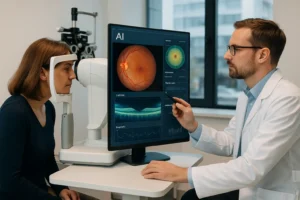What It Is and How It Affects Vision
Astigmatism is a common vision condition that occurs when the cornea or lens of the eye is irregularly shaped. This imperfection prevents light from focusing evenly on the retina, resulting in blurred or distorted vision at all distances. While it’s a common refractive error, like nearsightedness (myopia) or farsightedness (hyperopia), astigmatism affects vision differently and requires specific treatment.
In this guide, we’ll explore the causes, symptoms, and treatment options for astigmatism.
What Causes Astigmatism?
Astigmatism occurs when the eye’s cornea or lens has an irregular shape:
- Normal Eye: The cornea is round, like a basketball, allowing light to focus evenly on the retina.
- Astigmatic Eye: The cornea is shaped more like a football, causing light to focus at multiple points on or in front of the retina.
The exact cause of astigmatism isn’t always clear, but contributing factors include:
- Genetics: Astigmatism often runs in families.
- Injury or Surgery: Eye trauma or surgery can alter the cornea’s shape.
- Keratoconus: A condition where the cornea thins and becomes cone-shaped, leading to severe astigmatism.
Types of Astigmatism
- Corneal Astigmatism: Caused by an irregularly shaped cornea.
- Lenticular Astigmatism: Caused by an irregularly shaped lens inside the eye.
Additionally, astigmatism can coexist with other refractive errors:
- Myopic Astigmatism: Combined with nearsightedness.
- Hyperopic Astigmatism: Combined with farsightedness.
- Mixed Astigmatism: A combination of both nearsightedness and farsightedness in different meridians of the eye.
Symptoms of Astigmatism
Symptoms of astigmatism can vary depending on the severity of the condition. Common signs include:
- Blurred or distorted vision at all distances.
- Eye strain or discomfort, especially after prolonged tasks like reading or using a computer.
- Headaches due to overworking the eye muscles.
- Difficulty seeing at night, particularly with glare or halos around lights.
Diagnosing Astigmatism
Astigmatism is diagnosed during a comprehensive eye exam that includes:
- Visual Acuity Test: Measures clarity of vision by having you read letters on an eye chart.
- Keratometry: Measures the curvature of the cornea to determine its shape.
- Refraction Test: Identifies the prescription needed to correct vision.
Treatment Options for Astigmatism
Astigmatism is highly treatable with several effective options:
1. Eyeglasses
- Correct astigmatism by using cylindrical lenses that compensate for the irregular shape of the cornea or lens.
- Ideal for mild to moderate cases and provide an easy, non-invasive solution.
2. Contact Lenses
- Toric Lenses: Specifically designed to correct astigmatism by accommodating the cornea’s irregular shape.
- Rigid Gas Permeable (RGP) Lenses: Provide sharper vision by maintaining their shape on the cornea.
- Hybrid Lenses: Combine the comfort of soft lenses with the sharp vision of RGP lenses.
3. Orthokeratology (Ortho-K)
- Involves wearing specially designed rigid contact lenses overnight to reshape the cornea temporarily.
- Provides clear vision during the day without the need for glasses or contact lenses.
4. Refractive Surgery
- LASIK (Laser-Assisted In Situ Keratomileusis): Reshapes the cornea to correct astigmatism.
- PRK (Photorefractive Keratectomy): Similar to LASIK but reshapes the cornea’s surface.
- SMILE (Small Incision Lenticule Extraction): A minimally invasive option for certain types of astigmatism.
- Astigmatic Keratotomy: Surgical incisions are made in the cornea to reduce its irregular shape.
Managing Astigmatism
In addition to corrective treatments, managing astigmatism involves regular eye care:
- Routine Eye Exams: Regular check-ups help monitor changes in vision and ensure your prescription is up to date.
- Proper Lighting: Work and read in well-lit environments to reduce eye strain.
- Take Breaks: Follow the 20-20-20 rule: Look at something 20 feet away for 20 seconds every 20 minutes during prolonged screen time.
FAQs About Astigmatism
Q: Can astigmatism get worse over time?
A: Astigmatism can change slightly as you age, especially if it’s linked to other conditions like keratoconus. Regular eye exams are crucial for monitoring changes.
Q: Is astigmatism hereditary?
A: Yes, astigmatism often runs in families, so it’s important to have children’s eyes checked regularly if there’s a family history.
Q: Can astigmatism be cured?
A: While it cannot be permanently cured without surgery, it can be effectively managed with glasses, contacts, or temporary reshaping treatments like Ortho-K.
Conclusion: Clear Vision Is Possible
Astigmatism, though common, doesn’t have to limit your vision or quality of life. With a range of treatment options available, from glasses and contact lenses to advanced surgical techniques, you can achieve clear and comfortable vision tailored to your lifestyle.
At Bridgemill Eyecare, we specialize in diagnosing and treating astigmatism with personalized care and state-of-the-art technology. Schedule an appointment today to learn how we can help you see your world more clearly.





